

What Is Dyslexia? As with other learning disabilities, dyslexia is a lifelong challenge that people are born with.
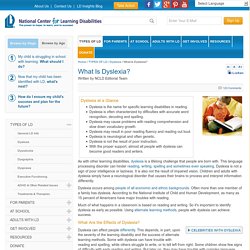
This language processing disorder can hinder reading, writing, spelling and sometimes even speaking. Dyslexia is not a sign of poor intelligence or laziness. It is also not the result of impaired vision. Test for Dyslexia: 37 Common Symptoms. Dyslexia Teaching Help. Dyslexia is a life-long condition.

With proper help people with dyslexia can learn to read and/or write well. Early identification and treatment is the key to helping dyslexics achieve in school and in life. Most people with dyslexia need help from a teacher, tutor, or therapist specially trained in using a multisensory, structured language approach. It is important for these individuals to be taught by a method that involves several senses (hearing, seeing, touching) at the same time.
Types of Accommodations. FAT City: Reading and Decoding. Strategies for Teaching Reading Comprehension. Upon completion of this section, you will: Understand the components of reading comprehension Receive ideas for making the text personally relevant Learn how to teach active engagement with the text Obtain extension activities for all learning styles Traditionally, reading comprehension was narrowly thought to encompass answering multiple-choice questions after reading a story or passage.

While this may be one form of reading comprehension, it is not comprehensive and does not take into account the stages of reading comprehension, requirements for understanding different genres of text, or understanding text when read silent versus orally. Comprehension of Fiction video by The Jerry L. Johns Literacy Clinic at Northern Illinois University Paula, an eighth grade student with dyslexia, cannot manage to answer multiple choice questions unless they are read aloud to her. Improving Comprehension For Students With Dyslexia. Strategies for Teachers. Upon completion of this section, you will Acquire general recommendations for the classroom that enrich learning for beginning readers and writers Identify tips for the different parts of the reading process that enrich comprehension, fluency, and vocabulary Have ideas to use when teaching children with visual deficits Sparking new ideas for your classroom Malcolm Alexander, the acclaimed dyslexic sculptor, tells a story about one of his teachers who made a difference.
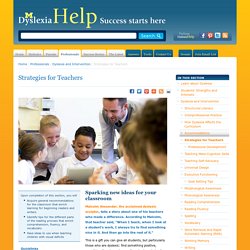
According to Malcolm, that teacher said, "When I teach, when I look at a student's work, I always try to find something nice in it. And then go into the rest of it. " This is a gift you can give all students, but particularly those who are dyslexic: find something positive, something they have done well, and acknowledge it. As a teacher, you most likely already have a print-rich environment in your classroom. The following suggestions may spark a new idea for your classroom. General recommendations.
Teaching Students with Dyslexia and Dysgraphia: Lessons from Teaching and Science. Teaching Students with Dyslexia and Dysgraphia: Lessons from Teaching and Science Authors Virginia Berninger Ph.D., Beverly Wolf M.Ed.
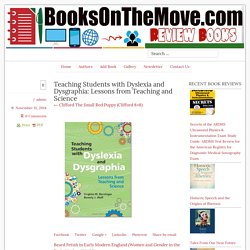
Availablity Usually ships in 24 hours Publisher : Brookes Publishing How can teachers provide effective literacy instruction for students with learning differences—while meeting the needs of all students in the class? Finally, a single accessible textbook answers that question for every KGÇô12 educator. Ginger Berninger, a seasoned researcher and former teacher, partners with 40-year teacher and teacher trainer veteran Beverly Wolf for a one-of-a-kind text that gives readers the best of both worlds: critical insights from scientific studies and lessons learned from actual teaching experience. Throughout the book, relevant research findings from diverse fields—including genetics, neuroscience, cognitive science, linguistics, and education—show teachers the why behind the how.
Teaching Special Needs Children : Teaching Students With Dyslexia. Helping dyslexic children within the classroom. © 2000, Patricia Hodge Dip.spld(dyslexia) Proficient reading is an essential tool for learning a large part of the subject matter taught at school.
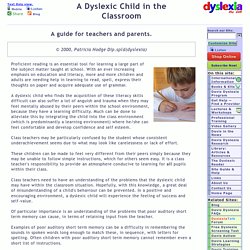
With an ever increasing emphasis on education and literacy, more and more children and adults are needing help in learning to read, spell, express their thoughts on paper and acquire adequate use of grammar. A dyslexic child who finds the acquisition of these literacy skills difficult can also suffer a lot of anguish and trauma when they may feel mentally abused by their peers within the school environment, because they have a learning difficulty.
Much can be done to alleviate this by integrating the child into the class environment (which is predominantly a learning environment) where he/she can feel comfortable and develop confidence and self esteem. Class teachers may be particularly confused by the student whose consistent underachievement seems due to what may look like carelessness or lack of effort. In the class: Teaching children with dyslexia Part 2: Ewelme C of E Primary School. From One Teacher to Another by Liz Ball. Dyslexics are lifelong learners.
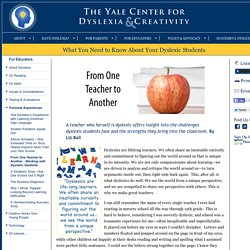
We often share an insatiable curiosity and commitment to figuring out the world around us that is unique in its intensity. We are not only compassionate about learning—we are driven to analyze and critique the world around us—to turn arguments inside out, then right-side back again. This, after all, is what dyslexics do well. We see the world from a unique perspective, and we are compelled to share our perspective with others. This is why we make great teachers. I can still remember the name of every single teacher I ever had starting in nursery school all the way through 12th grade.
Meanwhile, my entire childhood seemed to be spent deciphering this mysterious code—attempting to master the skill called reading that seemed to come so easily and automatically to my classmates. Dyslexia From a Student's Perspective.